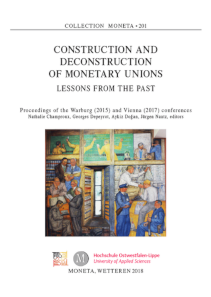October 18, 2018 – The current governance problems of the European Economic and Monetary Union entail a reopening of the debate about the adequate governance structures of monetary unions. Debt-burdens are a concern not only for a few members of the euro-zone but for the European Union as a whole. Other issues are differences in economic development, antagonistic political ideologies of national governments and a renewal of nationalism within the member states.
Nathalie Champroux, Georges Depeyrot, Aykiz Dogan, Jürgen Nautz (edd.), Construction and Deconstruction of Monetary Unions. Lessons from the Past. Proceedings of the Warburg (2015) and Vienna (2017) conferences, MONETA 201. Wetteren 2018. 228 pp., ISBN 978-94-91384-69-1. 70 euros.
For historians such pitfalls are well-known. Arrangements for monetary integration have not been restricted to the 21st century. Therefore, economic history especially can offer a useful contribution to the analysis of the construction and deconstruction of monetary unions as regards the keys to success, the integration processes and the governing practices. The most studied cases of monetary integration in European history are the Latin Monetary Union, the Scandinavian Monetary Union and the monetary union of Austria-Hungary. The first view on these historical cases is not very encouraging: All of them failed. But this publication is not characterised by pessimism as it also examines solutions and reasons for hope.
On the background of current problems within the euro-zone the DAMIN network discussed experiences in governing monetary cooperation, especially governing monetary unions, with a focus on historical findings.
The book can be ordered on the Moneta website.
We have already presented the DAMIN project in detail.
More information on the project can be obtained from the DAMIN website.
A detailed report on the 2018 conference is also available on CoinsWeekly.




